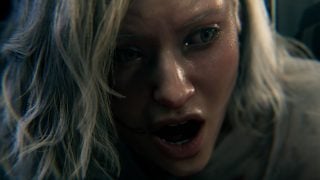A whole new batch of information on Xenoblade Chronicles X has been revealed through several videos on Nintendo’s official YouTube channel, a new official site, as well as interviews with the Monolith Soft development team. There’s quite a bit of information to cover here, so hold on tight.
If you’re planning the game up, be prepared for a lot of content. Keeping in mind that this is no JRPG for beginners, it’s been revealed that there’s close to 300 hours of gameplay available, if you choose to play it to completion. Even if you wanted to only cover the main plot, we should probably tell you that you’re still looking at about 100 to 120 hours, so either way you’re going to be spending quite a lot of time with your Wii U for this one.
Now with that information out of the way, we can move on to just what makes up all of that massive game. Obviously we don’t have all the details yet, but as we move closer to the release date we’re finding out more and more about it. For one, though many fans may already know this, Xenoblade Chronicles X is nothing more than a spiritual successor to the original Xenoblade Chronicles for the Wii. This is not a sequel, and will not feature any significant connections to the previous games of the series (yes, that includes Shulk). Tetsuya Takahashi, the game’s executive director, has instead stated that “Xeno” acts as more of a stamp for Monolith Soft, letting players know what kind of game they’re getting into, but that the histories and lore are completely unrelated.

Xenoblade Chronicles X features an absolutely massive world; one that’s said to put other open world Western RPG maps to shame. Taking place on the alien planet Mira, Xenoblade Chronicles X features a total of five traversable continents, so it’s a fair assumption that we’ll essentially get to explore the entire planet. It is possible to travel between these continents on foot, though the journey won’t be a short one. Not that it should be an issue, as Monolith Soft has included a fantastic fast-travel system, showcased briefly in Nintendo’s latest Nintendo Minute. The load times are also phenomenal, surely thanks to the data packs that are now available on the eShop to alleviate waiting.
Speaking of loading and multiple continents, there’s no need to worry about clunky loading screens interrupting your immersive journey through the world of Mira. As I said, the game does a great job of processing the environments, and the transitions between continents require no loading screen at all. Instead, they flow seamlessly into each other, just as they would in the real world. And trust me when I say you’ll know when you’ve entered a new continent, because the surroundings change drastically between the five. Showcased in the survival trailer, the five environments seem to be a safari like area, a jungle, a desert, a savannah, and an active volcano area bathed in lava.

Full exploration of these continents is not only possible, but encouraged. The game puts an emphasis on exploration, with player movement unlike anything in most other RPGs. The sprinting and jumping allows you to traverse the terrain in a way you just wouldn’t be able to in many other games, let alone JRPGs, and it looks awesome. If that wasn’t enough to completely immerse you, the game features a day-night cycle, which means you’ll be able to see the planet Mira from dusk until dawn.
Of course, with such a vast area to explore, you might want some help. From the beginning of the game you’ll see areas with lights shining from the ground up into the sky. These mark specific locations where you can install probes – machines that will help gather resources from the surrounding environments, get you bonuses, and provide fast travel and re-spawn points, among other things. You’ll be spending a lot of time installing these in the beginning to get you started, but you’ll continue to do so even later on in the game as you discover new areas and locations.
You can spend all of this time exploring Mira, but what’s a planet without its natural residents? Mira features a wide array of beautifully designed creatures that range from totally peaceful to absolutely hostile, and chances are you’re going to encounter plenty of both. One of my favorite things from the game I’ve seen thus far is the way the world around you acts as it would in real life; there are animals, creatures, aliens, or whatever you want to call them, wandering around in their natural habitats at all times, and it really makes you feel like you’re discovering this uncharted, unexplored land. Monolith Soft has taken great care in crafting these creatures, making sure they felt both familiar and exotic, and that they all fit into the world they’re living in.

If you do happen to run into a less-than-friendly inhabitant, you’ve luckily got more than a few combat resources at the ready. For one, you can and should have party members join you, as they will explore and fight alongside you if need be. The combat can be described as an evolution of the systems found in the previous Xenoblade, especially in regards to strategy. You have a selection of Arts at your disposal, and you can switch between ranged and melee combat on a whim. Your Arts do have a cooldown time, much like in an MMORPG, and also a second layer of power which you can choose to wait for. Your selection of Arts is also customizable to best suit your needs and preferences.
The skills you have available to you during battle do depend on the class of your character, though this can be changed whenever you want. Certain skills will stay behind and carry from your old class into your new class, so you can reap some benefits of certain classes while enjoying the benefits of another at the same time.

The creatures you run into on the field are also given levels, which you’ll want to pick your battles in the event that you won’t be able to defeat them (or if they’re just too massive for you to take on without some mechanized help). To aid in your fighting it is possible to lock onto an enemy’s specific body parts or weak points, and there will be special prompts similar to QTEs in the middle of combat that will provide extra stat bonuses and health regeneration.
There’s also the new Soul Voice system, which allows allies to heal, buff, or attack in specific ways. This was done so that players and party members don’t have to constantly focus on healing themselves and each other, and instead keep their main focus on attacking the enemy. Lastly, it’s important to remember that sneaking up on naturally aggressive enemies can be key, as if they spot you first you’ll flinch, allowing them an opportunity to attack. Additionally, watch out for special “tyrant” enemies. These guys may be lacking in levels, but they’ve always got something up their sleeve that’s sure to make your upcoming battle tougher.
Naturally, with a game this big, there’s quite a lot to keep track of, which may be intimidating to first time players. However, Monolith Soft is adamant in their stance that this game is not for first time players, and instead for people who are already familiar with the series and at least some aspects of how it works. In fact, they’ve stated that not only do they know that there’s a barrier of entry, but that they still wanted to create something complex regardless. I think it’s safe to say they’ve achieved their goal.
Takahashi also stated that many of the game’s story quests are gated, meaning that certain main plot progression isn’t available to the player until specific, unrelated objectives are completed. The development team made this decision in an effort to bar players from getting too overwhelmed in such a huge world, and to keep them from getting lost in what they should be doing next. Essentially, it’s a system that allows for players to experience the world without feeling confused by it.

Despite being made to appeal to a wide global audience, Xenoblade Chronicles X is distinctly a JRPG at its core, and nothing quite shows that aspect like the gigantic, mechanized Skells. These massive mobile suits were said to be inspired from mecha anime, such as the incredibly popular Gundam series, as well as their appearances in previous “Xeno” titles. Giant mech suits as a whole have almost become synonymous with Japanese sci-fi settings, so it’s no wonder that the Skells are an integral part of Chronicles X.
Takahashi mentioned that the inclusion of Skells is a way to achieve a near-future like setting with technology that’s out of our hands, but have it still feel like it could be attainable in our own future. In Japan, the idea of mechanized suits is not unlike America’s idea of the flying car, so Takahashi states that with the Skells there’s a sense of appeal deeply rooted in that nostalgic future gazing. Unfortunately, you’re going to have to play at least about 20 to 30 hours of the game before you get to march around in your very own customizable Skell.
Lastly, Xenoblade Chronicles X will feature some aspects of multiplayer gameplay. While not required, the option to play with others is there for those who need or want it. Optional multiplayer missions, which use squads of players online, have been included in the game because Takahashi states the world of X is like that of an MMO. He said that the ability to team up with other players would help foster that feeling of aiding humanity in creating their new home on Mira. Additionally, because the world is so vast, it has been noted that a feeling of loneliness is known to creep up from time to time. By implementing these multiplayer options, players can halt that feeling in its tracks.

Xenoblade Chronicles X is said to be a culmination of many different game ideas that the development team at Monolith Soft have been wanting to try for a very long time. With so much to do and so many hours to invest in this game, it looks to us like they’ve gotten all their wishes answered.
Xenoblade Chronicles X will be released in just a few days on December 4, and you can pre-order your copy today.
Leave a Comment

